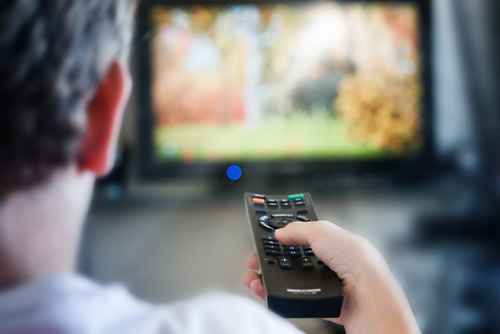I have a longstanding love-hate relationship with television. And, for 20 years now, video description has hung like a shadow over this relationship.
I grew up on the great classic comedies of the 1970s: "All in the Family," "The Mary Tyler Moore Show," and "M.A.S.H." I spent far too many summer vacation hours lazily watching programs from "Love Boat" to gameshows. I later adopted sitcoms like "Cheers" and "The Cosby Show," along with a sprinkling of a few medical and legal dramas. In other words, I was a pretty typical American TV watcher.
Yet, there was always a disappointing aspect to TV programs (okay, there are many in fact, but that's another story). There was always the question: "What’s going on?" And too often, there wasn't anyone willing or able to answer it for me. After all, as a blind person, I missed the visual information these programs presented: telltale facial expressions, audience laughter not triggered by dialogue, the silent entrance of a new character and, of course, the complete shift of setting. These, and many other aspects about television, are confounding to people who cannot see the screen (or who cannot see it very well).
As a consequence, I have what may be unhealthy love for the work of Aaron Sorkin, the screenwriter whose shows from "Sports Night," to "West Wing," to "Studio 60" were heavily dialogue-driven. These days, I find very little TV that I want to watch, and I'm mostly snarling at my teenage and young-adult daughters about their TV viewing choices (typical parent, I guess).
Meanwhile, in the 1990s, WGBH brought us its Descriptive Video Service (DVS), which brought movies and some public television shows to life. For me, and as importantly, my sighted family, DVS was a blessing, providing much more information about movies and shows, thereby relieving my family of the pressure to provide haphazard description.
Also during the early 90s, closed captioning was beginning to take off, providing access for people who are deaf or have hearing loss. Disability advocates (yours truly among them) began pushing for a law to require TV programs to be captioned and described. In 1996, Communications Act amendments were passed, bringing us Section 255, which required telecommunications access, but also Section 713, which required captioning of TV programs. Advocates tried hard at that time to get description required as well, but representatives of the television industry strenuously objected to description; apparently captioning would be accepted as a requirement, but description would not.
Nonetheless, the 1996 Act did require the Federal Communications Commission (FCC) to study description, and in 2000 the agency announced that it would require the broadcast networks as well as the largest nonbroadcast networks (generally this means cable networks), to provide 50 hours per quarter of programming with video description. The FCC believed it had the authority to require what amounts to a "pilot" effort of this sort. So, in April 2002, the requirement went into effect, and several networks started airing programs with description. However, the TV industry asked the courts to overturn the FCC requirement. Unfortunately, the Court of Appeals for the District of Columbia agreed, and tossed out the requirement.
Since that time, AFB and other advocates have worked to "reinstate" those minimal requirements, and we were finally successful in the Communications and Video Accessibility Act of 2010. So, that is how we ended up with this small but important step being taken now (as of July 2012) by the broadcast and top nonbroadcast TV networks to provide approximately four hours per week (50 hours per calendar quarter) of programs with video description.
So now what?
The two big, immediate challenges for television viewers with vision loss are to figure out which programs have description, and how to set their TVs to receive it. For information about programs, the best source right now is the FCC's video description page, which includes many resources and lists of programs that networks have indicated they are planning to provide with description. As for how to set the TV to get the description track, here's the information we've compiled. As we learn more, we'll fill in details.
If the programs you want aren't described, let the networks know you'd like them to be described. If you aren't able to receive the description track, contact your TV provider or broadcast station.
Personally, I'm curious about ABC's "Modern Family," and NBC's "The Office," which are now supposed to be described. In fact, I used to watch "The Office," but got tired of trying to follow the constant scene changes and weird switching between monologues and dialogue.
I'm definitely not the best person to tell you to watch more TV, but I suspect many of you, like most Americans, already watch a decent amount. I hope you will take a look at some of the programs that are to be described, and I hope you will let the networks know that you'd like to see more described programming. That's something we can all tune into.
We'll discuss description more in future posts. Meanwhile, let us know about your experiences with description in the comments.
Hand pointing remote at television photo courtesy of Shutterstock.
